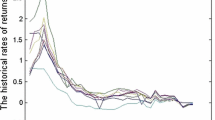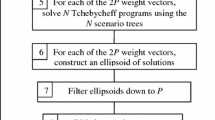Abstract
In this paper a portfolio optimization problem with bounded parameters is proposed taking into consideration the minimax risk measure, in which liquidity of the stocks is allied with selection of the portfolio. Interval uncertainty of the model is dealt with through a fusion between interval and random variable. As a result of this, the interval inequalities are converted to chance constraints. A solution methodology is developed using this concept to obtain an efficient portfolio. The theoretical developments are illustrated on a large data set taken from National Stock Exchange, India.




Similar content being viewed by others
References
Markowitz H 1952 Portfolio selection. J. Finance 7(1): 77–91
Markowitz H 1959 Portfolio selection: efficient diversification of investments. New York: Wiley
Konno H and Wijayanayake A 2001 Portfolio optimization problem under concave transaction costs and minimal transaction unit constraints. Math. Program. 89(2): 233–250
Kellerer H, Mansini R and Speranza M G 2000 Selecting portfolios with fixed costs and minimum transaction lots. Ann. Oper. Res. 99(1–4): 287–304
Fang Y, Lai K K and Wang S Y 2006 Portfolio rebalancing model with transaction costs based on fuzzy decision theory. Eur. J. Oper. Res. 175(2): 879–893
Choi U J, Jang B G and Koo H K 2007 An algorithm for optimal portfolio selection problem with transaction costs and random lifetimes. Appl. Math. Comput. 191(1): 239–252
Glen J J 2011 Mean–variance portfolio rebalancing with transaction costs and funding changes. J. Oper. Res. Soc. 62(4): 667–676
Zhang W G, Zhang X and Chen Y 2011 Portfolio adjusting optimization with added assets and transaction costs based on credibility measures. Insur. Math. Econ. 49(3): 353–360
Zhang X, Zhang W G and Cai R 2010 Portfolio adjusting optimization under credibility measures. J. Comput. Appl. Math. 234(5): 1458–1465
Woodside-Oriakhi M, Lucas C and Beasley J 2013 Portfolio rebalancing with an investment horizon and transaction costs. Omega 41(2): 406–420
Mao J C 1970 Models of capital budgeting, EV vs ES. J. Finan. Quant. Anal. 4(05): 657–675
Konno H and Yamazaki H 1991 Mean–absolute deviation portfolio optimization model and its applications to Tokyo stock market. Manage. Sci. 37(5): 519–531
Simaan Y 1997 Estimation risk in portfolio selection: the mean variance model versus the mean absolute deviation model. Manage. Sci. 43(10): 1437–1446
Chunhachinda P, Dandapani K, Hamid S and Prakash A J 1997 Portfolio selection and skewness: evidence from international stock markets. J. Bank. Finance 21(2): 143–167
Konno H and Suzuki K I 1995 A mean–variance–skewness portfolio optimization model. J. Oper. Res. Soc. Jpn. 38(2): 173–187
Konno H and Shirakawa H 1994 Equilibrium relations in a capital asset market: a mean absolute deviation approach. Finance Eng. Jpn. Markets 1(1): 21–35
Grootveld H and Hallerbach W 1999 Variance vs downside risk: is there really that much difference? Eur. J. Oper. Res. 114(2): 304–319
Jansen D W, Koedijk K G and de Vries C G 2000 Portfolio selection with limited downside risk. J. Empirical Finance 7(1): 247–269 (special issue on Risk Management)
Yang J and Qiu W 2005 A measure of risk and a decision-making model based on expected utility and entropy. Eur. J. Oper. Res. 164(3): 792–799
Young M R 1998 A minimax portfolio selection rule with linear programming solution. Manag. Sci. 44(5): 673–683
Cai X, Teo K L, Yang X and Zhou X Y 2000 Portfolio optimization under a minimax rule. Manag. Sci. 46(7): 957–972
Teo K and Yang X 2001 Portfolio selection problem with minimax type risk function. Ann. Oper. Res. 101(1–4): 333–349
Deng X T, Li Z F and Wang S Y 2005 A minimax portfolio selection strategy with equilibrium. Eur. J. Oper. Res. 166(1): 278–292
Wu Z W, Song X F, Xu Y Y and Liu K 2009 A note on a minimax rule for portfolio selection and equilibrium price system. Appl. Math. Comput. 208(1): 49–57
Sharma A and Mehra A 2013 Portfolio selection with a minimax measure in safety constraint. Optimization 62(11): 1473–1500
Ida M 2003 Portfolio selection problem with interval coefficients. Appl. Math. Lett. 16: 709–713
Lai K, Wang S, Xu J, Zhu S and Fang Y 2002 A class of linear interval programming problems and its application to portfolio selection. IIEE Trans. Fuzzy Syst. 10: 698–704
Giove S, Funari S and Nardelli C 2006 An interval portfolio selection problem based on regret function. Eur. J. Oper. Res. 170(1): 253–264
Liu S T 2011 The mean–absolute deviation portfolio selection problem with interval-valued returns. J. Comput. Appl. Math. 235: 4149–4157
Tan M 2012 Interval number model for portfolio selection with liquidity constraints. In: Fuzzy engineering and operations research, vol. 147. Berlin–Heidelberg: Springer, pp. 31–39
Liu Y J, Zhang W G and Zhang P 2013 A multi-period portfolio selection optimization model by using interval analysis. Econ. Model. 33(0): 113–119
Wu M, Kong D W, Xu J P and Huang N J 2013 On interval portfolio selection problem. Fuzzy Optim. Decis. Ma. 12(3): 289–304
Kumar P, Panda G and Gupta U C 2015 Portfolio rebalancing model with transaction costs using interval optimization. Opsearch 52(4): 827–860
Kumar P, Panda G and Gupta U C 2013 Generalized quadratic programming problem with interval uncertainty. In: Proceedings of the 2013 IEEE International Conference on Fuzzy Systems (FUZZ), pp. 1–7
Kumar P, Panda G and Gupta U C 2016 An interval linear programming approach for portfolio selection model. Int. J. Oper. Res. 27(1–2): 149–164
Bhurjee A K, Kumar P and Panda G 2015 Optimal range of Sharpe ratio of a portfolio model with interval parameters. J. Inf. Optim. Sci. 36(4): 367–384
Markov S 1979 Calculus for interval functions of a real variable. Computing 22(4): 325–337
Yan X S 2008 Liquidity, investment style, and the relation between fund size and fund performance. J. Financ. Quant. Anal. 43: 741–767
Kumar P and Panda G 2017 Solving nonlinear interval optimization problem using stochastic programming technique. Opsearch 54(4): 752–765
Acknowledgements
The authors would like to thank the referees for their comments and suggestions that led the paper into the current form.
Author information
Authors and Affiliations
Corresponding author
Rights and permissions
About this article
Cite this article
Kumar, P., Panda, G. & Gupta, U.C. Stochastic programming technique for portfolio optimization with minimax risk and bounded parameters. Sādhanā 43, 149 (2018). https://doi.org/10.1007/s12046-018-0902-2
Received:
Revised:
Accepted:
Published:
DOI: https://doi.org/10.1007/s12046-018-0902-2




